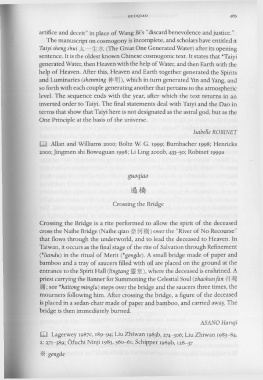Page 505 - The Encyclopedia of Taoism v1_A-L
P. 505
GUOQIAO
artifice and deceit" in place of Wang Bi's "discard benevolence and justice."
The manuscript on cosmogony is incomplete, and scholars have entitled it
Taiyi sheng shui '* - ~* (The Great One Generated Water) after its opening
sentence. It is the oldest known Chinese cosmogonic text. It states that *Taiyi
generated Water, then Heaven with the help of Water, and then Earth with the
help of Heaven. After this, Heaven and Earth together generated the Spirits
and Luminaries (shenming ;f!I1'ffl), which in turn generated Yin and Yang, and
so forth with each couple generating another that pertains to the atmospheric
level. The sequence ends with the year, after which the text returns in an
inverted order to Taiyi. The final statements deal with Taiyi and the Dao in
terms that show that Taiyi here is not designated as the astral god, but as the
One Principle at the basis of the universe.
Isabelle ROBINET
ID Allan and Williams 2000; Boltz W G. 1999; Bumbacher 1998; Henricks
2000; Jingmen shi Bowuguan 1998; Li Ling 2000b, 433-50; Robinet 1999a
guoqiao
Crossing the Bridge
Crossing the Bridge is a rite performed to allow the spirit of the deceased
cross the Naihe Bridge (Naihe qiao * 1iiJ m) over the "River of No Recourse"
that flows through the underworld, and to lead the deceased to Heaven. In
Taiwan, it occurs as the final stage of the rite of Salvation through Refinement
(*liandu) in the ritual of Merit (*gongde). A small bridge made of paper and
bamboo and a tray of saucers filled with oil are placed on the ground at the
entrance to the Spirit Hall (lingtang ii1it), where the deceased is enshrined. A
priest carrying the Banner for Summoning the Celestial Soul (zhaohun fan f:1 i)I,\l,
1iI; see *kaitongminglu) steps over the bridge and the saucers three times, the
mourners following him. After crossing the bridge, a figure of the deceased
is placed in a sedan-chair made of paper and bamboo, and carried away. The
bridge is then immediately burned.
ASANO Haruji
W Lagerwey I987C, 189-94; Liu Zhiwan 1983b, 274- 306; Liu Zhiwan 1983-84,
2: 271- 389; Ofuchi Ninji 1983, 560-61; Schipper 1989b, 128-37
* gongde

